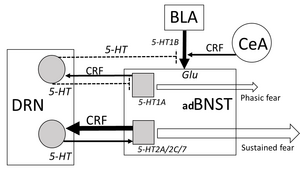Contribution of CRF and 5-HT in the anterodorsal BNST to phasic and sustained fear in freely behaving mice
Seidenbecher
Rodent data suggest that short-lasting (phasic) fear responses rely on the central amygdala, whereas more long-lasting (sustained) fear responses critically depend on the bed nucleus of the stria terminalis (BNST). This project is based on the hypothesis that sustained fear can be decisively modulated by corticotropin releasing factor (CRF) and serotonin (5-HT) in the antero-dorsal BNST (sdBNST) (s. Figure). The overall aim of the project is to elucidate key mechanisms in the adBNST underlying phasic/sustained fear with special focus on the contribution of CRF1- and 5-HT receptor-mediated processes. To address this project, we are going to use pharmacological and optogenetical approaches in combination with established fear conditioning protocols in the phasic/sustained fear mouse model.

Publications
